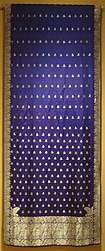
Back ساري (زي) Arabic سارى (هدوم) ARZ শাৰী Assamese Сари Bashkir Sari BCL Сары (вопратка) Byelorussian Сари Bulgarian साड़ी Bihari শাড়ি Bengali/Bangla Sari (roba) Catalan

A sari (sometimes also saree[1] or sadi)[note 1] is a women's garment from the Indian subcontinent.[2] It consists of an un-stitched stretch of woven fabric arranged over the body as a robe, with one end attached to the waist, while the other end rests over one shoulder as a stole,[3] sometimes baring a part of the midriff.[4][5][6] It may vary from 4.1 to 8.2 metres (4.5 to 9 yards) in length,[7] and 60 to 120 centimetres (24 to 47 inches) in breadth,[8] and is a form of ethnic wear in Bangladesh, India, Sri Lanka, Nepal, and Pakistan. There are various names and styles of sari manufacture and draping, the most common being the Nivi style.[9][10] The sari is worn with a fitted bodice also called a choli (ravike or kuppasa in southern India, and cholo in Nepal) and a petticoat called ghagra, parkar, or ul-pavadai.[11] It remains fashionable in the Indian subcontinent today.[12]
- ^ * "sari also saree". The American Heritage Dictionary of the English Language. 2022.
- "sari or less commonly saree". Merriam-Webster. 2022.
- "sari (also saree)". Lexico.com. 2022. Archived from the original on 14 August 2022.
- ^ Lynton, Linda (1995). The Sari. New York: Harry N. Abrams, Incorporated. ISBN 978-0-8109-4461-9.
- ^ Jermsawatdi, Promsak (1979). Thai Art with Indian Influences. Abhinav Publications. ISBN 9788170170907.
- ^ Alkazi, Roshan (1983) "Ancient Indian costume", Art Heritage
- ^ Cite error: The named reference
Boulangerwas invoked but never defined (see the help page). - ^ Ghurye (1951) "Indian costume", Popular book depot (Bombay); (Includes rare photographs of 19th century Namboothiri and nair women in ancient sari with bare upper torso)
- ^ Boulanger, Chantal (1997). Saris: An Illustrated Guide to the Indian Art of Draping. New York: Shakti Press International. ISBN 978-0-9661496-1-6.
- ^ Boulanger, Chantal (1997). Saris: An Illustrated Guide to the Indian Art of Draping. New York: Shakti Press International. p. 6.
- ^ Boulanger, Chantal (1997). Saris: an illustrated guide to the Indian art of draping. Shakti Press International. p. 55. ISBN 9780966149616.
Women of Andhra Pradesh claim that the modern sari is their own traditional drape . . . this claim is probably true.
- ^ Linda Lynton(1995), The Sari: Styles, Patterns, History, Technique ISBN 978-0-8109-4461-9, page 187; Quote: It is in the Karnataka (Mysore) and western Maharashtran area that the nivi style is believed to have originated..
- ^ Katiyar, Vijai Singh (2009). Indian saris : traditions, perspectives, design. New Delhi: Wisdom Tree in association with National Institute of Design, Ahmedabad. p. 211. ISBN 9788183281225. Retrieved 31 October 2015.
- ^ "Sari, Always in Vogue". Hinduism Today. Archived from the original on 31 May 2012. Retrieved 9 March 2018.
Cite error: There are <ref group=note> tags on this page, but the references will not show without a {{reflist|group=note}} template (see the help page).

